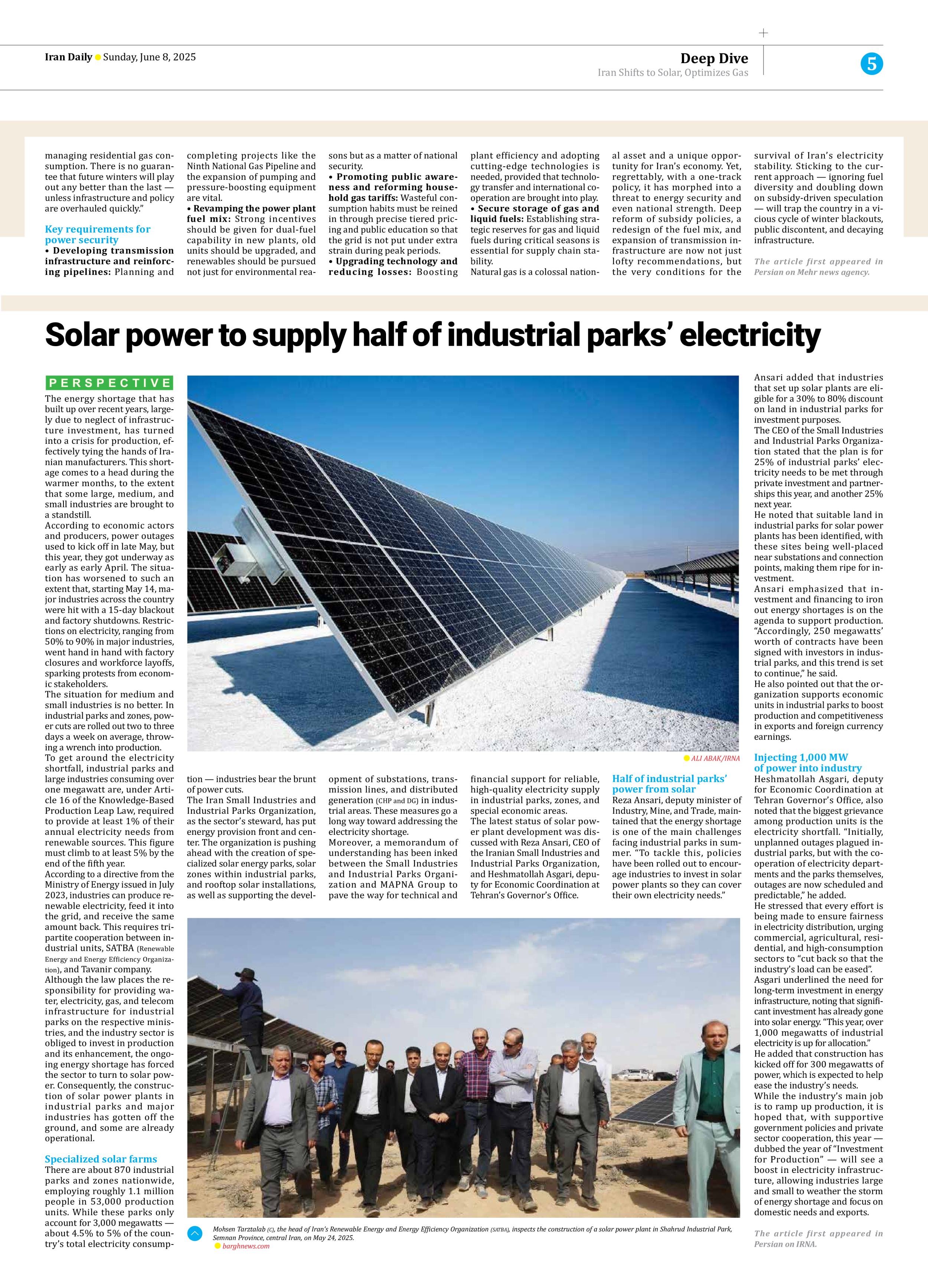
Solar power to supply half of industrial parks’ electricity
The energy shortage that has built up over recent years, largely due to neglect of infrastructure investment, has turned into a crisis for production, effectively tying the hands of Iranian manufacturers. This shortage comes to a head during the warmer months, to the extent that some large, medium, and small industries are brought to a standstill.
According to economic actors and producers, power outages used to kick off in late May, but this year, they got underway as early as early April. The situation has worsened to such an extent that, starting May 14, major industries across the country were hit with a 15-day blackout and factory shutdowns. Restrictions on electricity, ranging from 50% to 90% in major industries, went hand in hand with factory closures and workforce layoffs, sparking protests from economic stakeholders.
The situation for medium and small industries is no better. In industrial parks and zones, power cuts are rolled out two to three days a week on average, throwing a wrench into production.
To get around the electricity shortfall, industrial parks and large industries consuming over one megawatt are, under Article 16 of the Knowledge-Based Production Leap Law, required to provide at least 1% of their annual electricity needs from renewable sources. This figure must climb to at least 5% by the end of the fifth year.
According to a directive from the Ministry of Energy issued in July 2023, industries can produce renewable electricity, feed it into the grid, and receive the same amount back. This requires tripartite cooperation between industrial units, SATBA (Renewable Energy and Energy Efficiency Organization), and Tavanir company.
Although the law places the responsibility for providing water, electricity, gas, and telecom infrastructure for industrial parks on the respective ministries, and the industry sector is obliged to invest in production and its enhancement, the ongoing energy shortage has forced the sector to turn to solar power. Consequently, the construction of solar power plants in industrial parks and major industries has gotten off the ground, and some are already operational.
Specialized solar farms
There are about 870 industrial parks and zones nationwide, employing roughly 1.1 million people in 53,000 production units. While these parks only account for 3,000 megawatts — about 4.5% to 5% of the country’s total electricity consumption — industries bear the brunt of power cuts.
The Iran Small Industries and Industrial Parks Organization, as the sector’s steward, has put energy provision front and center. The organization is pushing ahead with the creation of specialized solar energy parks, solar zones within industrial parks, and rooftop solar installations, as well as supporting the development of substations, transmission lines, and distributed generation (CHP and DG) in industrial areas. These measures go a long way toward addressing the electricity shortage.
Moreover, a memorandum of understanding has been inked between the Small Industries and Industrial Parks Organization and MAPNA Group to pave the way for technical and financial support for reliable, high-quality electricity supply in industrial parks, zones, and special economic areas.
The latest status of solar power plant development was discussed with Reza Ansari, CEO of the Iranian Small Industries and Industrial Parks Organization, and Heshmatollah Asgari, deputy for Economic Coordination at Tehran’s Governor’s Office.
Half of industrial parks’ power from solar
Reza Ansari, deputy minister of Industry, Mine, and Trade, maintained that the energy shortage is one of the main challenges facing industrial parks in summer. “To tackle this, policies have been rolled out to encourage industries to invest in solar power plants so they can cover their own electricity needs.”
Ansari added that industries that set up solar plants are eligible for a 30% to 80% discount on land in industrial parks for investment purposes.
The CEO of the Small Industries and Industrial Parks Organization stated that the plan is for 25% of industrial parks’ electricity needs to be met through private investment and partnerships this year, and another 25% next year.
He noted that suitable land in industrial parks for solar power plants has been identified, with these sites being well-placed near substations and connection points, making them ripe for investment.
Ansari emphasized that investment and financing to iron out energy shortages is on the agenda to support production. “Accordingly, 250 megawatts’ worth of contracts have been signed with investors in industrial parks, and this trend is set to continue,” he said.
He also pointed out that the organization supports economic units in industrial parks to boost production and competitiveness in exports and foreign currency earnings.
Injecting 1,000 MW
of power into industry
Heshmatollah Asgari, deputy for Economic Coordination at Tehran Governor’s Office, also noted that the biggest grievance among production units is the electricity shortfall. “Initially, unplanned outages plagued industrial parks, but with the cooperation of electricity departments and the parks themselves, outages are now scheduled and predictable,” he added.
He stressed that every effort is being made to ensure fairness in electricity distribution, urging commercial, agricultural, residential, and high-consumption sectors to “cut back so that the industry’s load can be eased”.
Asgari underlined the need for long-term investment in energy infrastructure, noting that significant investment has already gone into solar energy. “This year, over 1,000 megawatts of industrial electricity is up for allocation.”
He added that construction has kicked off for 300 megawatts of power, which is expected to help ease the industry’s needs.
While the industry’s main job is to ramp up production, it is hoped that, with supportive government policies and private sector cooperation, this year — dubbed the year of “Investment for Production” — will see a boost in electricity infrastructure, allowing industries large and small to weather the storm of energy shortage and focus on domestic needs and exports.
The article first appeared in
Persian on IRNA.







